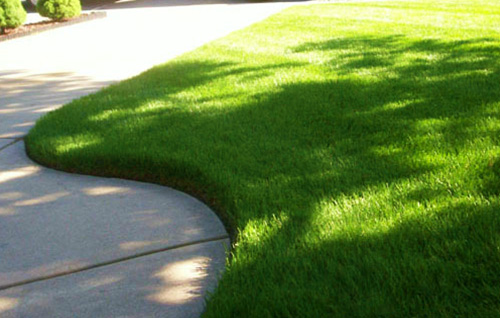
There are many different options, and it is important to select a seed variety that matches the amount of sun and shade exposure in your yard. It is also important to choose grass with care and maintenance requirements conducive to your schedule and lifestyle. Also think about whether children or pets will use the lawn frequently when you evaluate its ability to withstand typical traffic levels.
Grass Types
There are two main categories of turf grass, warm season and cool season. Warm season grass originates in the far South and grows best in hot weather – but will not survive in Winnipeg. Cool season grass generally originates from the North and is characterized by rapid growth in the spring and fall. Common cool season grasses include Kentucky Bluegrass, Fescue and Ryegrass.
Seed Mixtures
While some specialty seed sellers can provide single varieties of any one type of grass, most seed is sold as a blended mixture. Blended seed mixtures combine several different kinds of grass in one seed package. The percentage of each variety should be on the label. The strengths and weaknesses of each offset the others to keep your lawn green and healthy. This type of seed often contains disease and drought-resistant properties. You will find mixtures suited to sun or shade, high traffic and sports turf, drought resistance and other factors. Lawn seed blends that list Kentucky Bluegrass as the highest percentage in the mix are best suited to lawns that are in the sun most of the day. On the other hand, Fescue grass seed is best suited to more shaded environments and requires less watering. Ryegrass germinates quickly and is well suited for heavy traffic and sports fields. So, most grass seed blends will contain some of each, but the percentage will vary depending on where you intend on growing it.
Special Coatings
In the last few years some seed suppliers have been selling their seed with special coatings that attract and hold onto moisture. The coating holds water to help the seed stay moist and prevent it from drying out so quickly. So, you can get greater seeding success with less water.
Frog Eye
Heat, humidity, and dry conditions stress the health of lawns, and they get sick. For lawns that can mean fungus disease problems. We have seen widespread infections of “Red Thread” which causes pinkish brown patches that eventually recover on there own. We’ve also seen the spread of “Frog Eye” or Necrotic Ring Spot which is far more serious without an easy fix. It is identified by sunken (dish like) circles with a green tuft of grass in the middle. These patches must be dug out and disposed of before new soil and sod/seed can be expected to grow.
Mushrooms
This year’s summer has been filled with high levels of moisture due to the amount of rain fall. The moisture in the soil creates the perfect condition for mushrooms to thrive. Mushrooms are the reproductive fruit of fungi that is located underground. The organisms are remarkable because of their great ability to help in the decomposing process and usually appear when organic matter such as dead tree roots, old mulch, or scraps of lumber are in the soil. Mushrooms are spread due to the release of spores from the gills of the mushroom. Although mushrooms can be unsightly to have in the lawn, they are not harmful to the lawn and even release nutrients into the lawn. To prevent mushrooms from spreading in your lawn, the best method is to pick any mushrooms when they appear. As well ridding your lawn of any decomposing material will prevent mushrooms from appearing in the future. If your lawn has standing water or remains damp for long periods after a rain, your soil may be compacted. Aerating your lawn can help improve drainage, which will, in turn, help decrease the moisture that encourages mushrooms.
What Causes Mushrooms?
Mushrooms are caused by mix of moisture, shade or cloudy weather, and rich, organic material in the soil.
